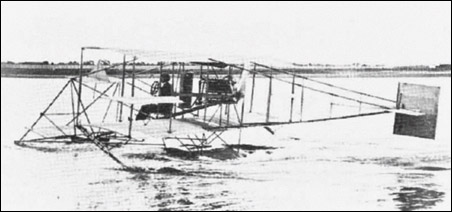 |
Curtiss Hydro1911 |  |
| SEAPLANE | Virtual Aircraft Museum / USA / Curtiss |
 |
The first successful flight of what was originally called a hydroaeroplane or simply hydro, but is now known as a seaplane, was made on 26 January, 1911. It used a clumsy tandem-float arrangement featuring a main float 1.82m wide by 1.52m long under the centre section, a smaller float forward, and a hydrofoil ahead of that to keep the bow from submerging at high speed. The wide design of the main float served two purposes. By being wide it was expected to function as an auxiliary wing to generate useful lift; also, its width would keep the spray pattern well outboard of the pusher propeller. Being short, it did not provide longitudinal stability on the water thus necessitating the forward float. By 1 February, a new arrangement was introduced, comprising a sled-shaped single float 3.65m long, 0.60m wide and 0.3m deep, under the pilot and engine to provide longitudinal stability; small floats for lateral stability were under the wingtips. At first, the main float was not compartmented. On a flight at Hammondsport, Curtiss took off in a hydro but a considerable amount of water had got into the float and as he nosed down to alight, all the water ran to the bow of the float and made the machine so nose heavy that Curtiss was unable to raise the nose and crashed into the lake. He recognized the problem as soon as it appeared and fortunately survived to correct it. An early refinement of the hydro was to eliminate the booms that supported the forward elevator and place a monoplane elevator on the bow of the float. As on contemporary landplanes, the hydro's forward elevators were soon eliminated.
|  COMPANY PROFILE | ||||||
 |

|
